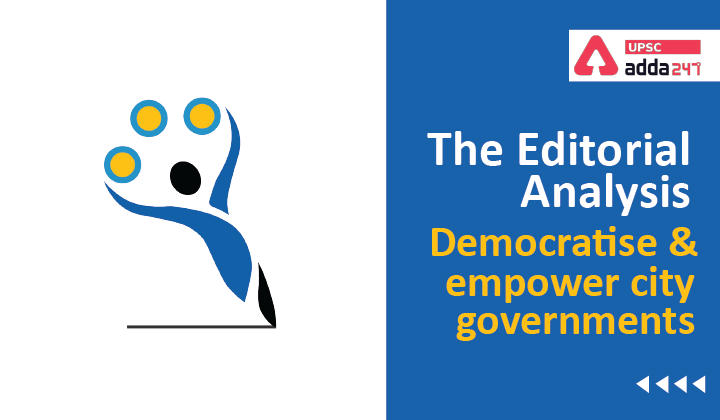Table of Contents
Local self governance: Relevance
- GS 2: Functions and responsibilities of the Union and the States, issues and challenges pertaining to the federal structure, devolution of powers and finances up to local levels and challenges therein.
RBI State Finances: Context
- RBI has released State Finances, Study of Budgets of 2021-22 report in November last year, where it discussed about the financial unviability of local self-governments in the pandemic.
Financial dependence of city governments: Key points
- Similar to the recommendations of the 15th Finance Commission, the report commented that there should be increase in functional autonomy of civic bodies their governance structure should be strengthened.
- An RBI survey of 221 municipal corporations (2020-21) revealed that more than 70% municipal corporations saw a decline in revenues while their expenditure rose by almost 71.2%.
- It means that not only the city governments were facing challenges in earning revenues, but expenditure also increased significantly.
- The RBI report also highlights the limited coverage of property tax and its failure in shoring up municipal corporation revenues.
- Organisation for Economic Co-operation and Development (OECD) data show that India has the lowest property tax collection rate in the world — i.e., property tax to GDP ratio.

Current local self government mechanism: Issues
- No place for elected representatives: Under the disaster management plan of action, cities are at the forefront to fight the pandemic; however, the elected leadership finds no place in them. Cities are continuously being seen as the adjuncts of State governments.
- No place for financial empowerment: Urban development is a state subject, which is more linked to political and democratic movements in states. While constitutional status to local self government provided the much-needed legitimacy to grassroot democracy, the financial empowerment did not get the required focus.
- Incomplete 12th schedule: Schedule 12 talks about empowering urban local bodies to perform 18 functions. These functions however, find no mention of financial empowerment.
- No investments: The idea of “competitive cites” where the plan was to attract investments in the urban centres by making their structures and land laws flexible could not succeed as not much investment has happened in cities.
- Snatching away the cities of power to collect taxes: Before Value Addition Tax (VAT) came into picture, octroi tax was one of the most sought for tax for the cities.
- For example: Pimpri-Chinchwad and Pune were two of the very high revenue-earning municipalities that depended on octroi, as both cities have strong bases of industrial production. However, arrival of VAT took away this source of revenue from them.
- Previously, while almost 55% of the total revenue expenditure of urban centres was met by octroi (e.g., Shimla), now, the grant—as suggested by the finance commission on the basis of demographic profile—covers only 15% of expenditure.
- Similarly, the arrival of GST has further eroded the financial autonomy of urban governments.
Financial empowerment of city governments: Suggested measures
- As highlighted by the RBI report, functional autonomy of city governments must be allowed.
- This functional autonomy should happen with three F’s: the transfer of ‘functions, finances and functionaries’ to city governments.
- A committee to review the 74th constitutional amendment suggested that 10% of income-tax collected from the cities was to be given back to them as a direct revenue grant from the central government.
- Cities must be treated as important centres of governance, where there should be transparency and adequate participation of the people.
- Cities should not be considered as entrepreneurship spaces where the sole driving force is to make them competitive to attract investments.
- The resources required for quantitative and qualitative data must be immediately provided to the cities to ensure a disaster risk reduction plan keeping vulnerable communities in mind.
- A piecemeal approach such as the concept of ‘smart cities’ must be shunned altogether. This approach further widens the gap between different sets of people.
- Rather, the grants from the Centre must be enhanced and cities should be asked to draw up their plans themselves based on priority seeking from city residents.
- Leadership in the cities must be elected for a term of five years.
- In some cities, the term of the mayor is for a year!
- Likewise, the third F, i.e., functionaries, must be transferred to the cities with a permanent cadre.
Also Read:




 TSPSC Group 1 Question Paper 2024, Downl...
TSPSC Group 1 Question Paper 2024, Downl...
 TSPSC Group 1 Answer key 2024 Out, Downl...
TSPSC Group 1 Answer key 2024 Out, Downl...
 UPSC Prelims 2024 Question Paper, Downlo...
UPSC Prelims 2024 Question Paper, Downlo...
